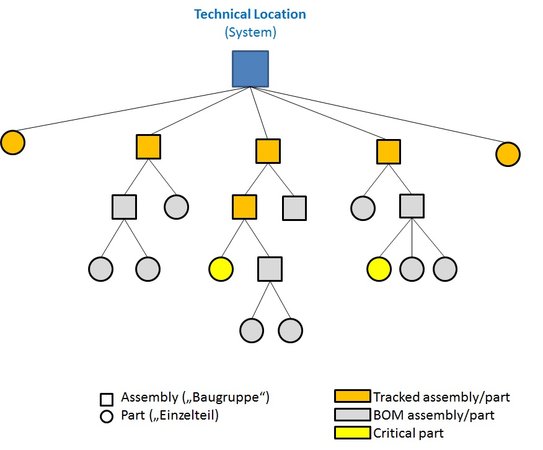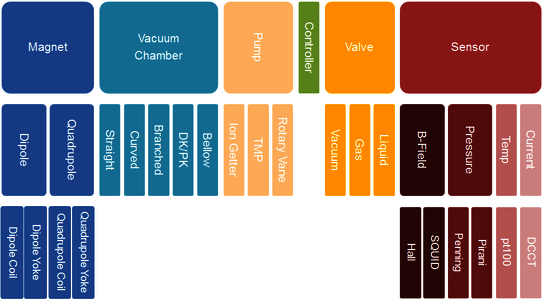The Data Model
A data model describes the data to be processed in an information system and the relationships to each other. The data model developed by the PLM team from System - Article - Components is a standard data model that can be found in the SAP System as Technical Place - Material - Equipment.
The system / functional location describes the system. It combines information from the AtB (Along the Beamline) lists, the IOL (Ionoptical Layout) and DMU (Digital Mock-Up). It answers the question: what is where?
• In SAP, this is called a functional location.
The article / material is the designed ("virtual") device. All components based on it are identical, i. interchangeable. Articles and all related data are identified by the AID.
• In SAP, the article is referred to as material.
A component / equipment is one (of several) physical realization of an article. Components and all their associated data are identified by the CID.
• In SAP, the component is referred to as equipment
The PLM Phases
The lifecycle of a product covers all phases, from idea and planning, through development and production, to installation, operation and maintenance to disposal.

Material Status
| Status | Materialtstatus | Beschreibung |
| A1 | Planning | Planning for the Material is finished and detailed specification has been released |
| A2 | Concept | Conceptual design report (CDR) is accepted |
| A3 | Final Design | Final design report (CDR) is accepted |
| A4 | Design Verification | Prototype has been built and tested |
| A5 | In Production | Material is ready for production / ready for purchase |
| A6 | Locked | Material can not be used anymore, it's locked |
| A7 | Inactive | Material no longer in use |
Equipment Status
| Status | Equipmentstatus | Beschreibung |
| INIT | Initial Status | Initial Equipment Status |
| PROD | Production [FAT] | Equipment currently in production |
| SHIP | Shipment [SATAa] | Equipment currently in shipment |
| FUNC | Functional Test [SATAb] | Equipment currently under functional Test SATAb |
| ADWN | Additional work needed | Equipment in storage, but needs additional treatment, not ready. |
| INTG | Integrated | Subcomponent is integrated to an assembly |
| STOR | Storage | Equipment currently in storage and ready |
| INST | Installation [SATBa] | Equipment currently in installation |
| COMM | Commissioning [SATBb] | Equipment under commissioning |
| OPER | Operation | Equipment ready for operation |
| MNTN | Maintenance | Equipment currently undergoing maintenance |
| INAC | Inactive | Equipment inactive |
| DISP | Disposal | Equipment disposed |
The Productstructure
The product structure is the arrangement of functional elements and represents the composition of a product of sub-elements and their assignment to each other.

Classification
Classification is the assignment of components or system based on their properties. With the help of the classification system, data can be structured and organized according to different characteristics and finally found again in the system. Here, similarities and differences between different objects can be shown.
The classification system in the SAP system is based on the assignment of characteristics. Accordingly, the classes are generated based on the required features.
A class always inherits all its characteristics, depending on which level of the hierarchy it is in, for example:
• The top class "Magnets" contains characteristics that apply to all types of magnets (design, type, polarity, field quality, inductance, etc.) ◦Dipoles require these features as well as some special others (B_Max, B_Min, B_Ramp_Rate, etc.).
◦ Quadrupoles need the general magnet features and their own others (g_max, g_min, g_ramp_rate etc.), but not those of the dipoles.
A classification system for the PLM components is currently being developed in SAP.





